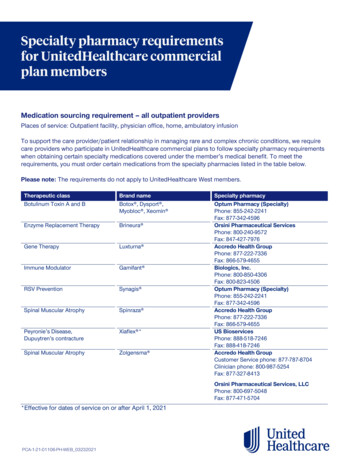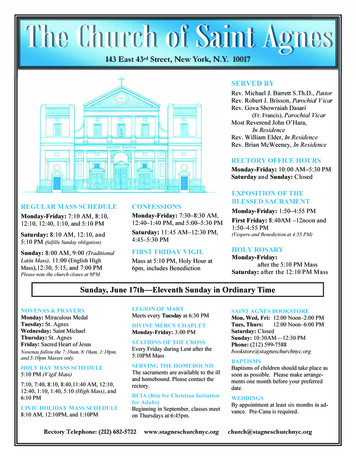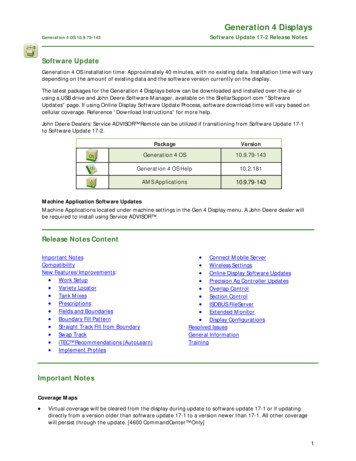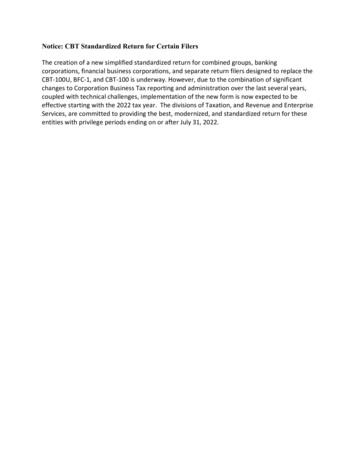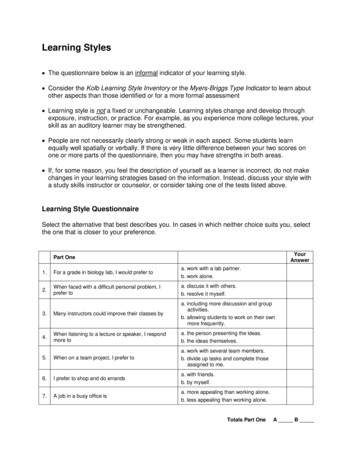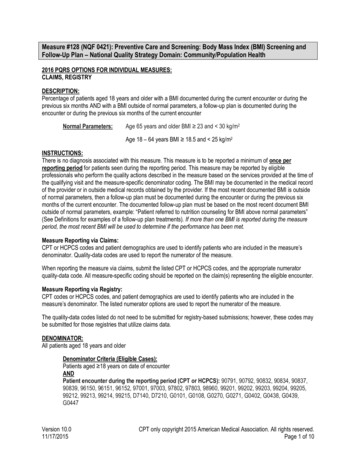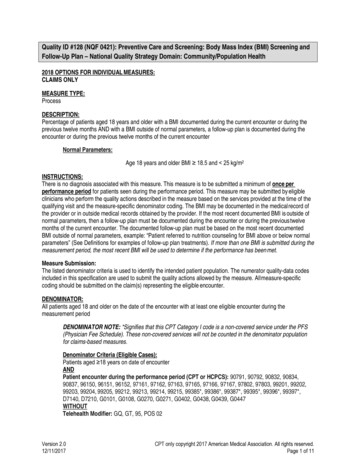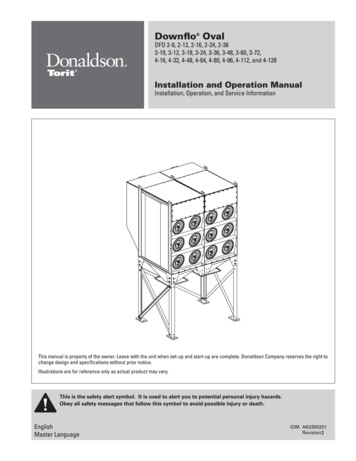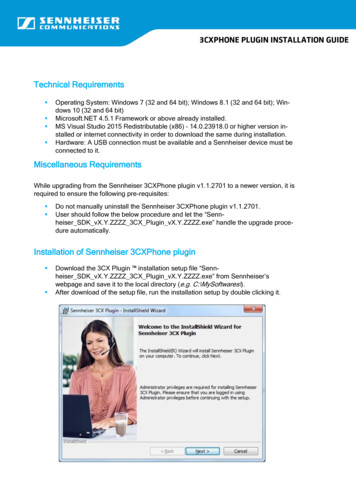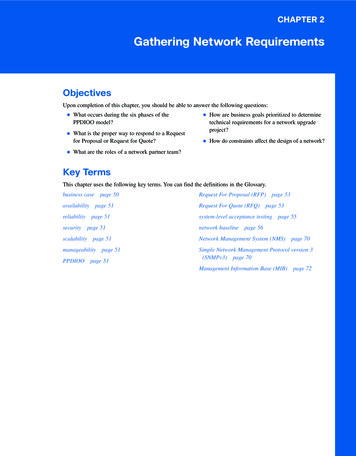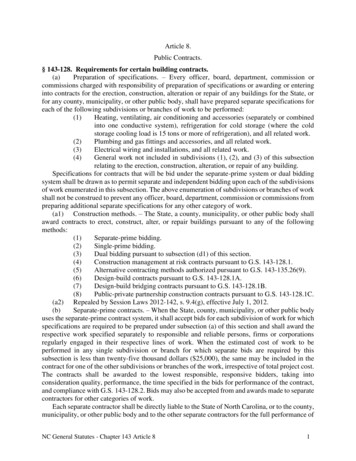
Transcription
Article 8.Public Contracts.§ 143-128. Requirements for certain building contracts.(a)Preparation of specifications. – Every officer, board, department, commission orcommissions charged with responsibility of preparation of specifications or awarding or enteringinto contracts for the erection, construction, alteration or repair of any buildings for the State, orfor any county, municipality, or other public body, shall have prepared separate specifications foreach of the following subdivisions or branches of work to be performed:(1)Heating, ventilating, air conditioning and accessories (separately or combinedinto one conductive system), refrigeration for cold storage (where the coldstorage cooling load is 15 tons or more of refrigeration), and all related work.(2)Plumbing and gas fittings and accessories, and all related work.(3)Electrical wiring and installations, and all related work.(4)General work not included in subdivisions (1), (2), and (3) of this subsectionrelating to the erection, construction, alteration, or repair of any building.Specifications for contracts that will be bid under the separate-prime system or dual biddingsystem shall be drawn as to permit separate and independent bidding upon each of the subdivisionsof work enumerated in this subsection. The above enumeration of subdivisions or branches of workshall not be construed to prevent any officer, board, department, commission or commissions frompreparing additional separate specifications for any other category of work.(a1) Construction methods. – The State, a county, municipality, or other public body shallaward contracts to erect, construct, alter, or repair buildings pursuant to any of the followingmethods:(1)Separate-prime bidding.(2)Single-prime bidding.(3)Dual bidding pursuant to subsection (d1) of this section.(4)Construction management at risk contracts pursuant to G.S. 143-128.1.(5)Alternative contracting methods authorized pursuant to G.S. 143-135.26(9).(6)Design-build contracts pursuant to G.S. 143-128.1A.(7)Design-build bridging contracts pursuant to G.S. 143-128.1B.(8)Public-private partnership construction contracts pursuant to G.S. 143-128.1C.(a2) Repealed by Session Laws 2012-142, s. 9.4(g), effective July 1, 2012.(b)Separate-prime contracts. – When the State, county, municipality, or other public bodyuses the separate-prime contract system, it shall accept bids for each subdivision of work for whichspecifications are required to be prepared under subsection (a) of this section and shall award therespective work specified separately to responsible and reliable persons, firms or corporationsregularly engaged in their respective lines of work. When the estimated cost of work to beperformed in any single subdivision or branch for which separate bids are required by thissubsection is less than twenty-five thousand dollars ( 25,000), the same may be included in thecontract for one of the other subdivisions or branches of the work, irrespective of total project cost.The contracts shall be awarded to the lowest responsible, responsive bidders, taking intoconsideration quality, performance, the time specified in the bids for performance of the contract,and compliance with G.S. 143-128.2. Bids may also be accepted from and awards made to separatecontractors for other categories of work.Each separate contractor shall be directly liable to the State of North Carolina, or to the county,municipality, or other public body and to the other separate contractors for the full performance ofNC General Statutes - Chapter 143 Article 81
all duties and obligations due respectively under the terms of the separate contracts and inaccordance with the plans and specifications, which shall specifically set forth the duties andobligations of each separate contractor. For the purpose of this section, "separate contractor" meansany person, firm or corporation who shall enter into a contract with the State, or with any county,municipality, or other public entity to erect, construct, alter or repair any building or buildings, orparts of any building or buildings.(c)Repealed by Session Laws 2001-496, s. 3, effective January 1, 2001.(d)Single-prime contracts. – All bidders in a single-prime project shall identify on theirbid the contractors they have selected for the subdivisions or branches of work for:(1)Heating, ventilating, and air conditioning;(2)Plumbing;(3)Electrical; and(4)General.The contract shall be awarded to the lowest responsible, responsive bidder, taking intoconsideration quality, performance, the time specified in the bids for performance of the contract,and compliance with G.S. 143-128.2. A contractor whose bid is accepted shall not substitute anyperson as subcontractor in the place of the subcontractor listed in the original bid, except (i) if thelisted subcontractor's bid is later determined by the contractor to be nonresponsible ornonresponsive or the listed subcontractor refuses to enter into a contract for the completeperformance of the bid work, or (ii) with the approval of the awarding authority for good causeshown by the contractor. The terms, conditions, and requirements of each contract between thecontractor and a subcontractor performing work under a subdivision or branch of work listed inthis subsection shall incorporate by reference the terms, conditions, and requirements of thecontract between the contractor and the State, county, municipality, or other public body.When contracts are awarded pursuant to this section, the public body shall make available tosubcontractors the dispute resolution process as provided for in subsection (f1) of this section.(d1) Dual bidding. – The State, a county, municipality, or other public entity may acceptbids to erect, construct, alter, or repair a building under both the single-prime and separate-primecontracting systems and shall award the contract to the lowest responsible, responsive bidder underthe single-prime system or to the lowest responsible, responsive bidder under the separate-primesystem, taking into consideration quality, performance, compliance with G.S. 143-128.2, and timespecified in the bids to perform the contract. In determining the system under which the contractwill be awarded to the lowest responsible, responsive bidder, the public entity may consider costof construction oversight, time for completion, and other factors it considers appropriate. The bidsreceived as separate-prime bids shall be received, but not opened, one hour prior to the deadlinefor the submission of single-prime bids. The amount of a bid submitted by a subcontractor to thegeneral contractor under the single-prime system shall not exceed the amount bid, if any, for thesame work by that subcontractor to the public entity under the separate-prime system. Theprovisions of subsection (b) of this section shall apply to separate-prime contracts awardedpursuant to this section and the provisions of subsection (d) of this section shall apply tosingle-prime contracts awarded pursuant to this section.(e)Project expediter; scheduling; public body to resolve project disputes. – The State,county, municipality, or other public body may, if specified in the bid documents, provide forassignment of responsibility for expediting the work on a project to a single responsible andreliable person, firm or corporation, which may be a prime contractor. In executing thisresponsibility, the designated project expediter may recommend to the State, county, municipality,NC General Statutes - Chapter 143 Article 82
or other public body whether payment to a contractor should be approved. The project expediter,if required by the contract documents, shall be responsible for preparing the project schedule andshall allow all contractors and subcontractors performing any of the branches of work listed insubsection (d) of this section equal input into the preparation of the initial schedule. Wheneverseparate contracts are awarded and separate contractors engaged for a project pursuant to thissection, the public body may provide in the contract documents for resolution of project disputesthrough alternative dispute resolution processes as provided for in subsection (f1) of this section.(f)Repealed by Session Laws 2001-496, s. 3, effective January 1, 2001.(f1)Dispute resolution. – A public entity shall use the dispute resolution process adoptedby the State Building Commission pursuant to G.S. 143-135.26(11), or shall adopt another disputeresolution process, which shall include mediation, to be used as an alternative to the disputeresolution process adopted by the State Building Commission. This dispute resolution process willbe available to all the parties involved in the public entity's construction project including thepublic entity, the architect, the construction manager, the contractors, and the first-tier andlower-tier subcontractors and shall be available for any issues arising out of the contract orconstruction process. The public entity may set a reasonable threshold, not to exceed fifteenthousand dollars ( 15,000), concerning the amount in controversy that must be at issue before aparty may require other parties to participate in the dispute resolution process. The public entitymay require that the costs of the process be divided between the parties to the dispute with at leastone-third of the cost to be paid by the public entity, if the public entity is a party to the dispute.The public entity may require in its contracts that a party participate in mediation concerning adispute as a precondition to initiating litigation concerning the dispute.(g)Exceptions. – This section shall not apply to:(1)The purchase and erection of prefabricated or relocatable buildings or portionsthereof, except that portion of the work which must be performed at theconstruction site.(2)The erection, construction, alteration, or repair of a building when the costthereof is three hundred thousand dollars ( 300,000) or less.(3)The erection, construction, alteration, or repair of a building by The Universityof North Carolina or its constituent institutions when the cost thereof is fivehundred thousand dollars ( 500,000) or less.Notwithstanding the other provisions of this subsection, subsection (f1) of this section shallapply to any erection, construction, alteration, or repair of a building by a public entity. (1925, c.141, s. 2; 1929, c. 339, s. 2; 1931, c. 46; 1943, c. 387; 1945, c. 851; 1949, c. 1137, s. 1; 1963, c.406, ss. 2-7; 1967, c. 860; 1973, c. 1419; 1977, c. 620; 1987 (Reg. Sess., 1988), c. 1108, ss. 4, 5;1989, c. 480, s. 1; 1995, c. 358, s. 4; c. 367, ss. 1, 4, 5; c. 509, s. 79; 1998-137, s. 1; 1998-193, s.1; 2001-496, ss. 3, 13; 2002-159, s. 42; 2007-322, s. 3; 2012-142, s. 9.4(g); 2013-401, s. 3).)§ 143-128.1. Construction management at risk contracts.(a)For purposes of this section and G.S. 143-64.31:(1)"Construction management services" means services provided by aconstruction manager, which may include preparation and coordination of bidpackages, scheduling, cost control, value engineering, evaluation,preconstruction services, and construction administration.(2)"Construction management at risk services" means services provided by aperson, corporation, or entity that (i) provides construction managementNC General Statutes - Chapter 143 Article 83
services for a project throughout the preconstruction and construction phases,(ii) who is licensed as a general contractor, and (iii) who guarantees the cost ofthe project.(3)"Construction manager at risk" means a person, corporation, or entity thatprovides construction management at risk services.(4)"First-tier subcontractor" means a subcontractor who contracts directly with theconstruction manager at risk.(b)The construction manager at risk shall be selected in accordance with Article 3D of thisChapter. Design services for a project shall be performed by a licensed architect or engineer. Thepublic owner shall contract directly with the architect or engineer. The public owner shall make agood-faith effort to comply with G.S. 143-128.2, G.S. 143-128.4, and to recruit and select smallbusiness entities when selecting a construction manager at risk.(c)The construction manager at risk shall contract directly with the public entity for allconstruction; shall publicly advertise as prescribed in G.S. 143-129; and shall prequalify andaccept bids from first-tier subcontractors for all construction work under this section. Theconstruction manager at risk shall use the prequalification process determined by the public entityin accordance with G.S. 143-135.8, provided that public entity and the construction manager atrisk shall jointly develop the assessment tool and criteria for that specific project, which mustinclude the prequalification scoring values and minimum required score for prequalification onthat project. The public entity shall require the construction manager at risk to submit its plan forcompliance with G.S. 143-128.2 for approval by the public entity prior to soliciting bids for theproject's first-tier subcontractors. A construction manager at risk and first-tier subcontractors shallmake a good faith effort to comply with G.S. 143-128.2, G.S. 143-128.4, and to recruit and selectsmall business entities. A construction manager at risk may perform a portion of the work only if(i) bidding produces no responsible, responsive bidder for that portion of the work, the lowestresponsible, responsive bidder will not execute a contract for the bid portion of the work, or thesubcontractor defaults and a prequalified replacement cannot be obtained in a timely manner, and(ii) the public entity approves of the construction manager at risk's performance of the work. Allbids shall be opened publicly, and once they are opened, shall be public records under Chapter 132of the General Statutes. The construction manager at risk shall act as the fiduciary of the publicentity in handling and opening bids. The construction manager at risk shall award the contract tothe lowest responsible, responsive bidder, taking into consideration quality, performance, the timespecified in the bids for performance of the contract, the cost of construction oversight, time forcompletion, compliance with G.S. 143-128.2, and other factors deemed appropriate by the publicentity and advertised as part of the bid solicitation. The public entity may require the selection ofa different first-tier subcontractor for any portion of the work, consistent with this section, providedthat the construction manager at risk is compensated for any additional cost incurred.When contracts are awarded pursuant to this section, the public entity shall provide for adispute resolution procedure as provided in G.S. 143-128(f1).(d)The construction manager at risk shall provide a performance and payment bond to thepublic entity in accordance with the provisions of Article 3 of Chapter 44A of the General Statutes.(e)Construction management at risk services may be used by the public entity only afterthe public entity has concluded that construction management at risk services is in the best interestof the project, and the public entity has compared the advantages and disadvantages of using theconstruction management at risk method for a given project in lieu of the delivery methodsNC General Statutes - Chapter 143 Article 84
identified in G.S. 143-128(a1)(1) through G.S. 143-128(a1)(3). The public entity may not delegatethis determination. (2001-496, s. 2; 2013-401, s. 5; 2014-42, s. 2.)§ 143-128.1A. Design-build contracts.(a)Definitions for purposes of this section:(1)Design-builder. – As defined in G.S. 143-128.1B.(2)Governmental entity. – As defined in G.S. 143-128.1B.(b)A governmental entity shall establish in writing the criteria used for determining thecircumstances under which the design-build method is appropriate for a project, and such criteriashall, at a minimum, address all of the following:(1)The extent to which the governmental entity can adequately and thoroughlydefine the project requirements prior to the issuance of the request forqualifications for a design-builder.(2)The time constraints for the delivery of the project.(3)The ability to ensure that a quality project can be delivered.(4)The capability of the governmental entity to manage and oversee the project,including the availability of experienced staff or outside consultants who areexperienced with the design-build method of project delivery.(5)A good-faith effort to comply with G.S. 143-128.2, G.S. 143-128.4, and torecruit and select small business entities. The governmental entity shall not limitor otherwise preclude any respondent from submitting a response so long as therespondent, itself or through its proposed team, is properly licensed andqualified to perform the work defined by the public notice issued undersubsection (c) of this section.(6)The criteria utilized by the governmental entity, including a comparison of theadvantages and disadvantages of using the design-build delivery method for agiven project in lieu of the delivery methods identified in subdivisions (1), (2),and (4) of G.S. 143-128(a1).(c)A governmental entity shall issue a public notice of the request for qualifications thatincludes, at a minimum, general information on each of the following:(1)The project site.(2)The project scope.(3)The anticipated project budget.(4)The project schedule.(5)The criteria to be considered for selection and the weighting of thequalifications criteria.(6)Notice of any rules, ordinances, or goals established by the governmental entity,including goals for minority- and women-owned business participation andsmall business participation.(7)Other information provided by the owner to potential design-builders insubmitting qualifications for the project.(8)A statement providing that each design-builder shall submit in its response tothe request for qualifications an explanation of its project team selection, whichshall consist of either of the following:NC General Statutes - Chapter 143 Article 85
a.A list of the licensed contractors, licensed subcontractors, and licenseddesign professionals whom the design-builder proposes to use for theproject's design and construction.b.An outline of the strategy the design-builder plans to use for opencontractor and subcontractor selection based upon the provisions ofArticle 8 of Chapter 143 of the General Statutes.(d)Following evaluation of the qualifications of the design-builders, the three most highlyqualified design-builders shall be ranked. If after the solicitation for design-builders not as manyas three responses have been received from qualified design-builders, the governmental entity shallagain solicit for design-builders. If as a result of such second solicitation not as many as threeresponses are received, the governmental entity may then begin negotiations with thehighest-ranked design-builder under G.S. 143-64.31 even though fewer than three responses werereceived. If the governmental entity deems it appropriate, the governmental entity may invite someor all responders to interview with the governmental entity.(e)The design-builder shall be selected in accordance with Article 3D of this Chapter.Each design-builder shall certify to the governmental entity that each licensed design professionalwho is a member of the design-build team, including subconsultants, was selected based upondemonstrated competence and qualifications in the manner provided by G.S. 143-64.31.(f)The design-builder shall provide a performance and payment bond to the governmentalentity in accordance with the provisions of Article 3 of Chapter 44A of the General Statutes. Thedesign-builder shall obtain written approval from the governmental entity prior to changing keypersonnel as listed in sub-subdivision (c)(8)a. of this section after the contract has been awarded.(2013-401, s. 4; 2014-42, s. 7.)§ 143-128.1B. Design-build bridging contracts.(a)Defini
listed subcontractor's bid is later determined by the contractor to be nonresponsible or nonresponsive or the listed subcontractor refuses to enter into a contract for the complete performance of the bid work, or (ii) with the approval of the a
